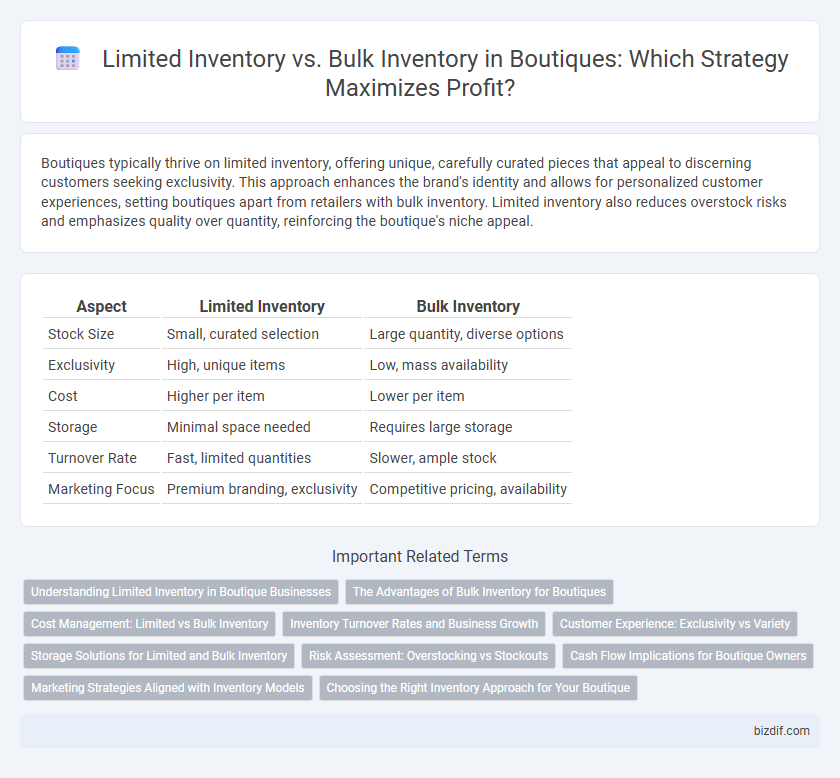Boutiques typically thrive on limited inventory, offering unique, carefully curated pieces that appeal to discerning customers seeking exclusivity. This approach enhances the brand's identity and allows for personalized customer experiences, setting boutiques apart from retailers with bulk inventory. Limited inventory also reduces overstock risks and emphasizes quality over quantity, reinforcing the boutique's niche appeal.
Table of Comparison
| Aspect | Limited Inventory | Bulk Inventory |
|---|---|---|
| Stock Size | Small, curated selection | Large quantity, diverse options |
| Exclusivity | High, unique items | Low, mass availability |
| Cost | Higher per item | Lower per item |
| Storage | Minimal space needed | Requires large storage |
| Turnover Rate | Fast, limited quantities | Slower, ample stock |
| Marketing Focus | Premium branding, exclusivity | Competitive pricing, availability |
Understanding Limited Inventory in Boutique Businesses
Limited inventory in boutique businesses fosters exclusivity and unique product offerings that attract discerning customers seeking rare items. Managing smaller stock quantities requires precise demand forecasting and agile supply chain strategies to minimize overstock and reduce holding costs. This approach enhances brand identity by emphasizing quality and scarcity, distinguishing boutiques from mass-market retailers with bulk inventory models.
The Advantages of Bulk Inventory for Boutiques
Bulk inventory allows boutiques to secure better pricing per unit, significantly increasing profit margins. It ensures consistent product availability, reducing stockouts and enhancing customer satisfaction. Holding larger quantities also enables boutiques to capitalize on seasonal trends and exclusive supplier deals.
Cost Management: Limited vs Bulk Inventory
Limited inventory in boutiques reduces holding costs and minimizes markdown risks by aligning stock closely with current demand. Bulk inventory benefits from economies of scale, lowering per-unit cost but increases expenses related to storage, insurance, and potential obsolescence. Effective cost management balances order quantity with demand forecasting to optimize cash flow and profit margins.
Inventory Turnover Rates and Business Growth
Limited inventory in boutiques typically results in higher inventory turnover rates, driving faster product cycling and increased exclusivity, which boosts customer demand and business growth. Bulk inventory may reduce costs per unit but often leads to slower inventory turnover, tying up capital and increasing storage expenses that can hinder agility and growth. Balancing inventory volume to optimize turnover rates enhances cash flow, maximizes profitability, and supports sustainable boutique expansion.
Customer Experience: Exclusivity vs Variety
Limited inventory in a boutique creates an exclusive shopping experience by offering unique, carefully curated items that appeal to customers seeking individuality and rarity. Bulk inventory provides a wider variety, catering to diverse preferences and enhancing customer choice but may dilute the sense of exclusivity. Balancing exclusivity with variety is essential to optimize customer satisfaction and brand identity in boutique retail.
Storage Solutions for Limited and Bulk Inventory
Boutiques managing limited inventory benefit from compact, modular storage solutions that maximize vertical space and facilitate easy access to high-value items. In contrast, bulk inventory requires durable shelving systems with customizable compartments to efficiently organize large quantities while maintaining product visibility and reducing retrieval time. Implementing inventory-specific storage optimizes floor space, enhances stock management, and supports sales strategies tailored to either exclusive or high-volume merchandise.
Risk Assessment: Overstocking vs Stockouts
Limited inventory in boutiques minimizes the risk of overstocking, reducing storage costs and product obsolescence, but increases the potential for stockouts and lost sales. Bulk inventory lowers the risk of stockouts by ensuring product availability, yet raises the chance of overstocking, tying up capital and increasing markdowns on unsold items. Effective risk assessment balances inventory levels to optimize cash flow, meet customer demand, and maintain brand exclusivity.
Cash Flow Implications for Boutique Owners
Limited inventory management in boutiques enhances cash flow by reducing holding costs and minimizing capital tied up in stock, allowing for quicker turnover and fresh product offerings. Bulk inventory purchasing often requires significant upfront investment, potentially straining cash reserves and increasing storage expenses, but may provide cost savings per unit and supply stability. Boutique owners must balance inventory volume with cash flow capabilities to maintain operational liquidity and optimize profitability.
Marketing Strategies Aligned with Inventory Models
Marketing strategies for boutiques with limited inventory emphasize exclusivity and scarcity, leveraging high-quality visuals and storytelling to attract niche audiences willing to pay premium prices. In contrast, boutiques managing bulk inventory prioritize broad reach and volume sales, using discount promotions and loyalty programs to quickly move larger quantities and maintain turnover. Aligning marketing efforts with the inventory model helps optimize sales cycles and enhances customer engagement based on supply constraints.
Choosing the Right Inventory Approach for Your Boutique
Selecting the right inventory approach for your boutique hinges on understanding customer demand and product exclusivity. Limited inventory emphasizes unique, high-quality items driving scarcity and premium pricing, while bulk inventory focuses on volume sales and consistent availability to meet broader customer needs. Analyzing sales data and market trends helps optimize stock levels, reduce holding costs, and enhance customer satisfaction.
Limited Inventory vs Bulk Inventory Infographic

 bizdif.com
bizdif.com